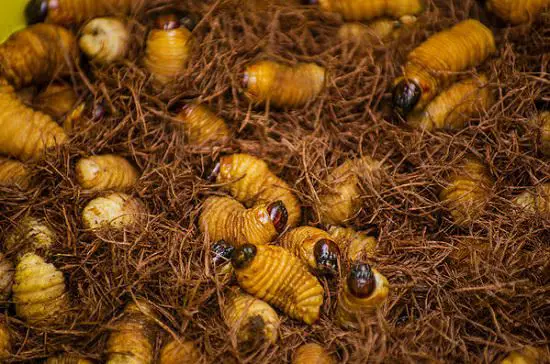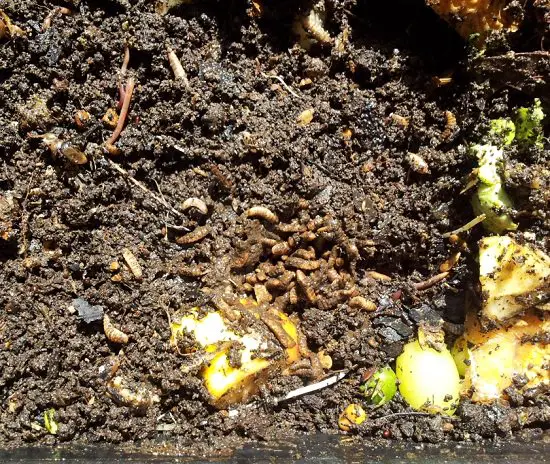Got Maggots in your home or garden? Do not worry. Discover Where Do Maggots Come From & How To Get Rid Of Them in our expert guide.
Find out Where Do Maggots Come From & How To Get Rid Of Them with the help of effective tips for expelling them from your home and garden.
Here is How To Get Rid Of Mealybugs
What Are Maggots?
‘Maggots’ are the larvae of any species of dipteran fly, whether it’s a fruit fly, housefly, or other types of fly. Female flies lay eggs, which hatch into these wriggling creatures that are known as maggots.
In just a few days, these larvae transform into pupae and eventually into adult flies. It’s an intriguing but not pleasant process when maggots start appearing in our homes.
If you are still curious, you can review the detailed life cycle on this educational website.
Where Do Maggots Come From?
Maggots are the larval stage of a fly. They can come from the eggs laid by female flies in a moist or decaying environment. These eggs can hatch within a day or two and release small, white, worm-like creatures that feed on the decaying matter around them. As they grow, they shed their skins and eventually transform into pupae, which later hatch into adult flies.
Maggots flourish in warm and humid environments that provide the ideal conditions for fly breeding. So they are commonly found in areas with rotting food, animal remains, or other forms of organic matter. When fruit and vegetables decompose, they produce sugar and alcohol, which attract fruit flies and lead to the appearance of maggots. They can also be found in garbage containers or compost bins that are not properly sealed. These conditions make it easy for flies to lay their eggs and for maggots to prosper.
Where Do Maggots Thrive in Your Home?
Water Pools
Standing pools of water are a hotbed for maggots, particularly rat-tailed maggots that can even breathe underwater. Once mature, these maggots leave the water and hatch into flies. Stagnant water can also attract mothfly maggots, which thrive in this type of environment.
Decaying Meat
Decaying meat is another favorite spot for maggots to thrive. Blow or bottle fly maggots, which are part of the Calliphorid class, develop in rotten meat and feed on the flesh. When they mature, they form a red cocoon before turning into flies. These flies are always looking for alternate food sources and can be seen on carpets, kitchen counters, and other areas.
Living Beings
Living beings, including pets and humans, can also attract flies that lay eggs on open wounds. This can lead to an infestation of maggots that eat away at healthy tissue, slow down the healing process, and cause disease. It’s crucial to treat wounds promptly to prevent infestations.
For severe cases of maggot infestation in pets, consult a veterinarian. By taking preventive measures and keeping your home clean, you can significantly reduce the likelihood of maggot infestations.
Check Out Our Article on Getting Rid of Carpenter Bees
What Plants Do Maggots Infest the Most?
1. Cabbage
Cabbage is a favorite target of root maggots, which damage the root system and cause plants to wilt and die.
2. Turnip
Maggots are the most common pest for turnips. They lay eggs at the base of the plant, which later develop into maggots that feed on the roots.
3. Broccoli
Broccoli plants can be attacked by aphids, which in turn can attract maggots that feed on the aphids and the plants.
4. Carrot
Flies lay eggs near the base of carrot plants, and when they hatch into maggots. They burrow into the carrot root, making it unsuitable for consumption.
Learn how to keep bugs off flowers
5. Onion
Maggots are a significant pest for onions and can cause stunted growth and reduced yield, leading to decreased plant quality.
6. Radish
Maggots burrow into the roots of radish plants. They cause damage and reduce the yield.
7. Cauliflower
The same maggots that affect broccoli also affect cauliflower plants. They feed on the aphids that attack the plants, causing damage and reducing yield.
8. Brussel’s Sprouts
Brussels’s sprouts are also prone to aphid infestations, which can attract maggots that feed on both the aphids and the plants.
9. Collards
Collard plants can be a host to a variety of pests, including maggots, which can feed on the roots and cause stunted growth.
10. Mustard
Mustard plants can attract a variety of pests, including root maggots, which can cause significant damage to the plants.
Did you know that Root maggots are the most common type of maggots that affect plants? They feed on plant sap, reducing nutrient availability and weakening the growth of plants. On the other hand, Onion and cabbage maggots are the most prevalent in the northern part of the U.S.
Symptoms of Maggot Infection in Plants
Root maggots are tiny white worms that measure about 1/4 inch in length. Regardless of the species, they all look alike. When plants are infested with root maggots, it’s common to observe signs such as loss of vigor, irrational wilting, and the death of developing plants. Additionally, you may notice holes on the tubers or roots, indicating infestation.
To determine if your plants are infested with root maggots, it’s crucial to check the root system beneath the soil surface, where you may find these tiny, white worms. Moreover, you can check the cracks and crevices near the plant or at the base of the stem to spot elongated white eggs measuring about 1/8 inch in length in these areas.
How to Get Rid of Maggots?
- To protect young plants from adult flies, wrap them in plastic or muslin cloth.
- Create paper collars with slits and place them on the ground around the plant to prevent flies from depositing eggs.
- Use hot pepper, activated charcoal, or diatomaceous earth to deter adult flies from plants.
- To check for infestation, uproot one or two plants and examine the roots. Infected plants should be destroyed immediately.
- After harvesting root crops, uproot them to prevent flies from overwintering and spreading in the garden.
- Repel maggot colonization in your garbage bin by covering it with lime, banana peels, vinegar, or salt.
- Release natural predators like rove beetles and nematodes to control housefly populations in the garden.
- Chemical control is ineffective once maggots have pervaded the root system of the plant.
- If pesticides are used for maggot control, apply them weekly during early spring.
- Remove maggot-infested plants from the garden before winter and destroy them rather than compost them.
- You can opt for organic control through crop rotation of commonly affected plants.






